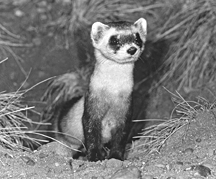The cosmos under our feet: In a new book, a Cornell professor wanders through a subterranean wonderland
By Blaine Friedlander

David Wolfe sees the forest for the trees ... and the earthworms for the soils, the prairie dogs for the grasslands and the Rhizobium for the nitrogen.
In his first book, Tales From the Underground: A Natural History of Subterranean Life (Perseus Books, May 2001), Wolfe, Cornell professor of horticulture, wanders through a subterranean wonderland explaining how all the pieces of nature's puzzle fit together.
The world below is little known. Until recently, scientists did not realize that microbial life existed some 10 feet under us, believing that life could not be sustained at that depth. It turns out that microbial life-forms team deep below the surface with "extremophiles," which are microbes that exist without oxygen or sunlight, and – closer to the Earth's core – at temperatures well beyond water's boiling point. Extremophile microbes, seems, are useful in remediating soil tainted from oil spills and chemical dumping.
Wolfe paints an animated portrait of a wide variety of critters, scientific characters and – in the context of ecology – the exchange between humanity and other creatures. For example, while Charles Darwin is best known for his famous treatise The Origin of Species , Wolfe recounts Darwin's less well-known work, The Formation of Vegetable Mould Through the Action of Worms, a book that became a best seller in its day. Worms keep soil healthy, serving to aerate and add nutrients through their fecal matter. "The fact is that Darwin did not consider earthworms inconsequential, and his interest in them spanned almost his entire professional career," Wolfe writes.
When thinking of life underground, few city dwellers consider the importance of prairie dogs and black-footed ferrets (one of the rarest mammals in North America) and the well-being of soil. Wolfe explains that prairie dogs, a keystone species, are sophisticated land managers, keeping grasses trimmed to specific heights, and their burrowing and tunneling expertise benefits many other species. Early in the 20th century, prairie dogs were considered pests by landowners, and the U.S. Biological Survey "helped" ranchers eradicate the animals by applying 1,610 tons of strychnine in 1920 alone. Strychnine-coated grain was applied to 18 million acres of ranch- and farmland and 4.5 million acres of public land. Prairie dog colonies were reduced from inhabiting 250 million acres in 1870 to 1.5 million acres by 1960. The poisoning of prairie dogs continues today.
The problem with prairie dog eradication: Black-footed ferrets have been left with little to eat, they have become susceptible to the bubonic plague and their populations have dwindled to the edge of extinction. Writes Wolfe of the ferrets, which kept the prairie dogs in check, "Beneath a sweet and endearing exterior is a hunter with extremely strong jaws, a long, supple body for maneuvering in the subterranean and a keen sense of smell."
Tales From the Underground does not ignore agriculture, exploring the relationships of soil, plants and roots. The root underworld alone bursts with activity. Wolfe recounts how a young German soil microbiologist named Martinus Bierjerinck became the first to isolate Rhizobium . The bacterium produces nodules the size of corn kernels on the roots of legumes, where it "fixes" ammonium, a nitrogen fertilizer, from nitrogen gas in the soil. This process makes legumes important as a rotation crop, sparing farmers the work and expense of putting down processed fertilizer.
In one chapter, "Germ Warfare," Wolfe explains how noted Rutgers University soil biologist Selman Waksman discovered streptomycin and other miracle drugs from his soil samples.
"Many of our most potent antibiotics for fighting human disease are derived from the soil," writes Wolfe. "It is my hope that as more of us become aware of life beneath our feet and its relevance to our well-being, we will be inclined to work together to maintain the biological integrity of the underground and preserve some of what we find there for future generations."
Media Contact
Get Cornell news delivered right to your inbox.
Subscribe